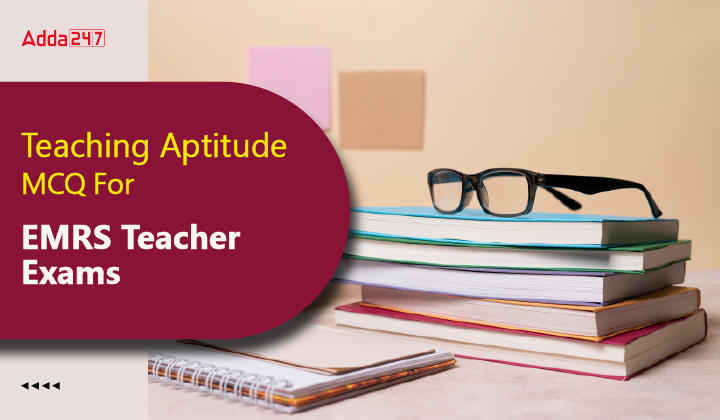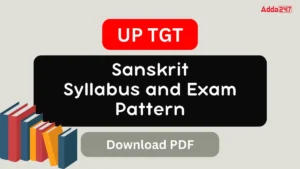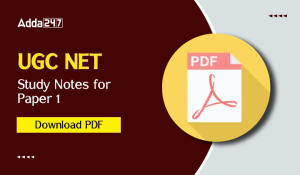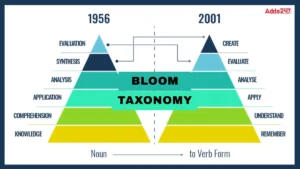Table of Contents
Eklavya Model Residential School (EMRS) Recruitment Exam will be held on 16,17, 23, 24 December 2023. Candidate who had started preparing for EMRS TGT PGT Examination, should know about EMRS Exam Pattern 2023. Teaching Aptitude Section carries 10 question in EMRS Examination. Here we are going to provide Teaching Aptitude MCQ For EMRS TGT PGT Teacher Exams to crack the examination.
Teaching Aptitude MCQ For EMRS Exam
EMRS Staff Selection Exam (ESSE-2023), it is crucial for candidates to meticulously plan and strategize their study approach for each topic. To aid in this preparation, we are offering an EMRS Teaching Aptitude Questions with detailed Solutions for your benefit.
| Teaching Aptitude | Details |
|---|---|
| Total Question | 10 |
| Total marks | 10 |
| Marking System | 1 mark shall be awarded to every correct answer. |
| Negative Marking | 0.25 mark shall be deducted for every incorrect answer. |
EMRS Teaching Aptitude Section
EMRS Teaching Aptitude Section will be carrying 10 question for 10 marks in TGT PGT Exam. The Teaching Aptitude section of the EMRS exam is designed to assess your understanding of various aspects related to teaching and education.
EMRS Teaching Aptitude section aims to evaluate your pedagogical knowledge and your ability to effectively communicate and impart knowledge to students. Here are some key topics that you should focus on while preparing for the Teaching Aptitude section of the EMRS TGT PGT exam:
- Teaching-Nature, Characteristics, Objectives and Basic Requirements,
- Learner’s Characteristics,
- Factors affecting teaching,
- Methods of Teaching,
- Teaching Aids and Evaluation Systems.
- Experiential activity-based pedagogy and case study based
- National Education Policy (NEP)- 2020
Check: EMRS Admit Card 2023
Practice with Teaching Aptitude MCQ For EMRS Teacher Exams
Here we are providing EMRS Teaching Aptitude Question with answer in below for better practice in EMRS Exam Preparation.
Q1. NEP 2020 stated to establish a national repository of high-quality resources on foundational literacy and numeracy on Government Digital Platform. What is the name of the Govt. Digital platform?
(a) NCERT
(b) DIKSHA
(c) DISHA
(d) NISHITHA
Q2. Inclusive education assumes that we should change the ____ to fit the____.
(a) System, child
(b) Environment, family
(c) Child, environment
(d) Child, system
Q3. Learning disabilities may occur due to all of the following except-
(a) Cultural factors
(b) Cerebral dysfunction
(c) Emotional disturbance
(d) Behavioral disturbance
Q4. Which of the following is appropriate for environment conducive to thinking and learning in children?
(a) Passive listening for long periods of time
(b) Home assignments given frequently
(c) Individual tasks done by the learners
(d) Allowing students to take some decisions about what to learn and how to learn
Q5. Which psychologist formulated the theory in which interaction is considered the most important in language development of a child?
(a) Jean Piaget
(b) Lev Vygotsky
(c) BF Skinner
(d) Noam Chomsky
Q6. According to NCF, 2005, the role of a teacher has to be –
(a) Dictatorial
(b) Permissive
(c) Facilitative
(d) Authoritative
Q7. Inclusive education signifies-
(a) Having the same teaching methodology for all the children in the class.
(b) Having the same facilities for normal and differently-abled students.
(c) Having the same schools for normal and differently-abled students.
(d) Having different schools for normal and differently-abled students.
Q8. In India, learners with Special Educational Needs (SEN) do not include
(a) Children from backward classes.
(b) Children belonging to SC and ST.
(c) Children with locomotor disabilities.
(d) None of the above.
Q9. Which of the following is a feature of progressive education?
(a) Emphasis on scoring good marks in examinations
(b) Frequent tests and examinations
(c) Flexible time-table and seating arrangement
(d) Instruction based solely on prescribed text-books
Q10. The emphasis from teaching to learning can be shifted by
(a) Encouraging rote learning
(b) Adopting frontal teaching
(c) Focusing on examination results
(d) Adopting child-centered pedagogy
Q11. Which of the following is/are social and cultural forces that affect the growth and development of a child?
I. Prenatal and family care received by a child
II. The quality of schooling received by a child
III. The quality of peer group relationship and company of a child
(a) I, II and III
(b) Both I and III
(c) Both II and III
(d) Both I and II
Q12. Which of the following can help in close linkage between school and community?
I. Regular communication
II. Teachers guiding and advising parents
(a) Neither I nor II
(b) Only II
(c) Only I
(d) Both I and II
Q13. Who was the founder of psychoanalysis and gave theory of psychoanalysis?
(a) G.W Allport
(b) Carl Jung
(c) Alfred Adler
(d) Sigmund Freud
Q14. Howard Gardner’s Theory of multiple intelligences emphasizes –
(a) Conditioning skills in students
(b) General intelligence
(c) Common abilities required in school
(d) The unique abilities of each individual
Q15. _______ intelligence is the ability to understand and discern the feelings and intentions of others while _______ intelligence is the ability to understand one’s own feelings and motivations.
(a) Interpersonal, Intrapersonal
(b) Intrapersonal, interpersonal
(c) Interpersonal, social
(d) Social, intrapersonal
Q16. IQ = (Mental age Chronological age) X 100 was propounded by –
(a) Revised Stanford-Binet scale
(b) Minnesota paper form board test
(c) Binet-Simon
(d) None of the above
Q17. Gardner initially formulated seven intelligences. Which among the following is not one of them?
(a) Spatial
(b) Linguistic
(c) Interpersonal
(d) Naturalist
Q18. The concept of mental age was introduced by-
(a) Thorndike
(b) Guilford
(c) Binet
(d) Spearman
Q19. Classification of students in different groups on the basis of their IQ tends to _____ their self esteem and to ______ their academic performances.
(a) Decrease, decrease
(b) Decrease, have no effect on
(c) Increase, decrease
(d) Increase, increase
Q20. The factor ‘g’ in the Spearman definition of intelligence stands for –
(a) Genetic intelligence
(b) Generative intelligence
(c) General intelligence
(d) Global intelligence
Solutions
S1. Ans.(b)
Sol. A national repository of high-quality resources on foundational literacy and numeracy will be made available on government’s e-learning platform (DIKSHA).
S2. Ans.(a)
Sol. Inclusive education assumes that we should change the system to fit the child. Inclusive Education is a system of education that brings all students under the same framework, regardless of their strengths or weaknesses. Inclusive education thinks we need to adapt the system to suit the child.
S3. Ans.(a)
Sol. Learning disabilities may occur due to cerebral dysfunction, emotional disturbance and behavioral disturbance.S4. Ans.(d)
Sol. Conducive learning environment could be made more constant and enlivening by allowing students to take some decision about what and how to learn as it will:
• Promote the child-centered approach to education.
• Get students to focus on you now and then by not keeping slides up for too long.
• Give primacy to children’s experiences and needs.
• Allow children to work at their own pace freely and willingly.
• Provide them opportunities to foster their own strategy of learning.
S5. Ans.(b)
Sol. Two specific cognitive activities influenced by engagement with parents are play and language skills. The classic theory of cognitive development proposed by Lev Vygotsky underscores how social interaction can facilitate the development for play, language, and other cognitive skills, such as attention and memory.
S6. Ans.(c)
Sol. The National Curriculum Framework 2005 of India expects a teacher to be a facilitator of children’s learning in a manner that helps children to construct knowledge. Apart from instructional roles as collaborator and facilitator, a teacher functions today as a learner, counsellor, manager, assessor, and innovator.
S7. Ans.(c)
Sol. Inclusive Education can be defined as a learning environment that promotes the full personal, academic and professional development of all learners irrespective of race, class, gender, disability and language. It allows the children to develop friendship with their peers.
S8. Ans.(d)
Sol. Initially, according to western thinking, a learner with Special Educational Needs was defined as a child with visual, hearing, locomotor or intellectual disability. However, in India, a learner with SEN also includes learners from the disadvantaged and deprived communities. These includes the children belonging to the groups of child labour, street children, victims of natural catastrophes and social conflicts, ethnic and religious minorities, economically weaker section and those in extreme social and economic deprivation (SCs, STs, OBCs, disabled and girls).
S9. Ans.(c)
Sol. Progressive education: emphasizes to enhance skills and understanding of the learners by engaging with the contents and experiences.
Feature of Progressive Education:
• Education for society and democracy.
• Collaborative and cooperative learning.
• Learning as opposed to rote knowledge.
• Emphasis on lifelong learning and social skills.
• Flexible time-table and seating arrangement
S10. Ans.(d)
Sol. The emphasis from teaching to learning can be shifted by adopting child-centered pedagogy as it emphasizes upon:
• Enabling children to express their ideas freely.
• Allowing students to work at their own pace freely and willingly.
• Giving primacy to students’ experiences, understanding, and needs.
• Providing opportunities to students to foster their own strategy of learning.
• Catering totality of students’ experience that occurs in the educational process.
• Using different kinds of innovative learning strategies to address children’s’ diverse learning needs.
S11. Ans.(a)
Sol. What a child gets from this social and cultural environment for the growth and development of his potentials, influences the entire course of his/her development of his/her sense, he develops and becomes what s/he is permitted to and desired by these social and cultural forces.
A few of such conditions are pointed out below:
- Parental and family care received by a child.
- The economic and social status of the parents and the family. The quality of the neighbourhood and surrounding environment.
- The quality of schooling received by a child.
- The quality of peer group relationships and company of a child.
- The quality of treatment made available to a child and his family with regard to his caste, religion, nationality or citizenship.
- The quality of educational and vocational facilities and opportunities available to a child.
- The quality of the government, laws and organization of the society to which a child belongs.
The quality of the power and status enjoyed by the country to which a child belongs.
Hence, we conclude that all the above points are social and cultural forces that affect the growth and development of a child.
S12. Ans.(d)
Sol. School and community interface plays a crucial role in the cultural development of the learner by including the local culture into the various aspects of school activities as it provides an instant value to the knowledge as it shows communities and children that their own knowledge and beliefs are actually something worth.
As a teacher one should know about the cross-cultural understanding of the community where the school is. Tagore has said, “Where the mind is without fear” should be true for the schools.
Efforts are required to make the child free of fear, trauma and anxiety and helping the child to express views freely. To make this statement possible, teacher, besides teaching competencies, must have interaction and relations with the community so that all children in the neighbourhood are sent regularly to schools.
These interactions and relations with the community involve regular communication and guiding and advising parents.
As, Sarva Shiksha Abhiyan and subsequently the RTE Act has emphasized that the teacher should do continuous and comprehensive evaluation rather than one-time examination to assess students. They should hold parent’s meetings, apprise them about their ward’s progress and involve them in the growth and development of children.
In this way, community is a valuable resource and it is important for the school to communicate effectively with it. Hence, it can be concluded that regular communication, guiding and advising parents can help in close linkage between school and community.
S13. Ans.(d)
Sol. Psychoanalytic Approach: This approach developed by Sigmund Freud in the early 1900s, involves analysing the root causes of behaviour and feelings by exploring the unconscious mind and the conscious mind’s relation to it.
Psychoanalysis can take on a variety of forms, varying from practitioner to practitioner. Psychoanalytical and psychodynamic therapies are based on an individual’s unconscious thoughts and perceptions that have developed throughout their childhood, and how these affect their current behaviour and thoughts.
Psychoanalysis focuses on an individual’s unconscious, deep-rooted thoughts that often stem from childhood. Through free association, dreams or fantasies, clients can learn how to interpret deeply buried memories or experiences that may be causing them distress.
Hence, we conclude that Psychoanalytic approach of counselling was introduced by Freud.
S14. Ans.(d)
Sol. The theory of multiple intelligences suggests that there are a number of distinct forms of intelligence that each individual possesses in varying degrees. Gardner also emphasizes the cultural context of multiple intelligences. Each culture tends to emphasize particular intelligences
S15. Ans.(a)
Sol. Interpersonal intelligence is the ability to understand and discern the feelings and intentions of others while Intrapersonal intelligence is the ability to understand one’s own feelings and motivations.
S16. Ans.(a)
Sol. This was originally developed in 1905 as the Binet-Simon intelligence scale by Alfred Binet and Theodore Simon. It was administered to children to evaluate their mental age at a given chronological age.
S17. Ans.(d)
Sol. Linguistic intelligence (as in a poet),Logical-mathematical intelligence (as in a scientist),Musical intelligence (as in a composer),Spatial intelligence (as in a sculptor or airplane pilot),Bodily kinesthetic intelligence (as in an athlete or dancer),Interpersonal intelligence (as in a salesman or teacher), Intrapersonal intelligence (exhibited by individuals with accurate views of themselves).
S18. Ans.(c)
Sol. The concept of ‘Mental age’ was introduced by Alfred Binet, a French psychologist.
• According to Binet, ‘Intelligence means the capacity to judge well, to reason well, and to comprehend well’.
• He is also known for developing the first intelligence test with Simon in 1905.
Mental age is an estimate of a person’s cognitive development derived from raw score performance on intelligence, achievement, or neuropsychological tests. Mental age is most frequently estimated in children, likely due to the emergence and protracted developmental course of cognitive skills during this period.
S19. Ans.(b)
Sol. Classification of students in different groups on the basis of their IQ tends to decrease their self-esteem and has no effect on academic performance.
S20. Ans.(c)
Sol. General intelligence, also known as g factor, refers to the existence of a broad mental capacity that influences performance on cognitive ability measures. It refers to a general mental ability that, according to Spearman, underlies multiple specific skills, including verbal, spatial, numerical and mechanical.
Download Teaching Aptitude MCQ PDF For EMRS Teacher Exams
The direct Download link for Teaching Aptitude MCQ For EMRS Teacher Exams is given below. All the candidate can download Teaching Aptitude MCQ For EMRS Teacher Exams in English and Hindi.
| Teaching Aptitude MCQ For EMRS Teacher Exams | |
| Language | Download PDF |
| In English | Teaching Aptitude MCQ For EMRS Teacher Exams |
| In Hindi | Teaching Aptitude MCQ For EMRS Teacher Exams – Hindi |
| Important Links | |
| EMRS Recruitment 2023 | EMRS Syllabus 2023 |
| EMRS Exam Date 2023 | EMRS Previous Year Question Paper |




 UP TGT Sanskrit Syllabus and Exam Patter...
UP TGT Sanskrit Syllabus and Exam Patter...
 UGC NET Study Notes for Paper 1, Downloa...
UGC NET Study Notes for Paper 1, Downloa...
 Bloom Taxonomy, Purpose, Domains, Exampl...
Bloom Taxonomy, Purpose, Domains, Exampl...




